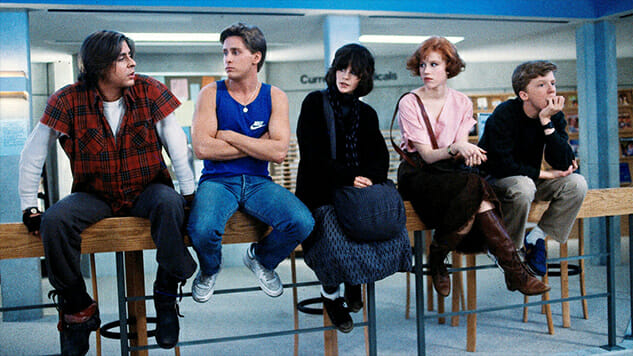
Each month, the Paste staff brings you a look at the best new selections from the Criterion Collection. Much beloved by casual fans and cinephiles alike, The Criterion Collection has for over three decades presented special editions of important classic and contemporary films. You can explore the complete collection here. In the meantime, because chances are you may be looking for something to give the discerning (raises pinkie) cinephile this month, find all of our Criterion picks here, and check out some of our top titles this January:
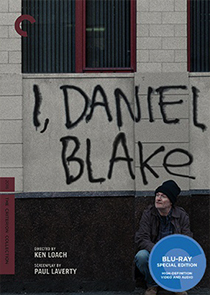 I, Daniel Blake
I, Daniel Blake
Year: 2016
Director: Ken Loach
A stunningly realistic, character-heavy docudrama, almost devoid of narrative structure and about the plight of working class characters in Northern England: Chances are, you’re watching a Ken Loach film. The director first gained international acclaim with his 1969 masterpiece Kes, the tale, both heartbreaking and invigorating, of friendship between an introverted poor kid and his kestrel. Almost 50 years later, Loach’s deft touch continues with I, Daniel Blake, his Palme D’or winning drama about a senior-age out-of-work carpenter (Dave Johns) befriending a poor single mother (Hayley Squires) and her children while fighting a broken system for his unemployment benefits. That’s pretty much the film’s plot in its entirety, but Loach keeps us glued to the screen by presenting developed, lived-in characters without ever giving into prejudicial renderings of the British working class.
The film never shies away from the heart-wrenching economic troubles its characters have to go through, but this isn’t a cinematic experience for miserabilists only: I, Daniel Blake drips with compassion and positivity without ever becoming cynically mawkish. It’s may be the most Ken Loach film Loach has ever made, so it’s a great starting point for newcomers, and Criterion’s transfer is impressively clean and crisp, definitely the best home video presentation you’re going to find. The extras are few but robust in content, and include a comprehensive making-of documentary. —Oktay Ege Kozak
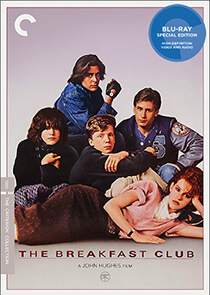 The Breakfast Club
The Breakfast Club
Year: 1985
Director: John Hughes
The Breakfast Club may seem as unlikely a Criterion edition as Armageddon, but considering Criterion’s mission of bringing culturally important and impactful films from all over the world to discerning film buffs, I can’t think of another movie that better encapsulated and enhanced the 1980s teenage experience, with all the positive and negative connotations that might conjure, than John Hughes’ iconic high school dramedy. The charm of the film lies in the simplicity of its premise: The whole thing is basically a chamber piece wherein each archetypal member of an ’80s movie high school clique is stuck in detention on a Saturday, left to work through their differences and confront their inner demons by gradually opening up to one another—but not without indulging silly teen comedy stuff, like how smoking marijuana apparently gives one the power to break glass by screaming. As such, some of the broader material may feel dated, but the tender performances by the future Brat Pack members, brought together by Hughes’ insightful writing when it comes to capturing the teenage experience of the time, serves a delicate balance between a time capsule into the period and a still-relevant examination of pubescent troubles. The original cut was supposedly much longer, so perhaps some vital romantic development between the characters, which otherwise have the tendency to feel forced, fell on the cutting room floor, although the deleted scenes found in this Criterion release don’t really contain them. The Breakfast Club is an evenly lit dialogue and character piece, so the great HD transfer isn’t really the big selling point here. Instead, fans are probably looking forward to the Criterion edition’s new extras more than anything else, and this release doesn’t disappoint, with new interviews from Molly Ringwald and Ally Sheedy, as well as some valuable, vintage making-of footage. —Oktay Ege Kozak
 Young Mr. Lincoln
Young Mr. Lincoln
Year: 1939
Director: John Ford
John Ford—embodiment of the American ideal; institutional director favorited by hardened cinephiles, casual film lovers and old-school auteurs like Sergei Eisenstein alike—does not cater too obliviously to the iconography of Abraham Lincoln (played by Henry Fonda as if Lincoln could’ve been the most charming union organizer any budding socialist has ever seen). Instead, Ford studies the moral mettle of Lincoln from a functional perspective: How does someone become a beloved member of a community? How does a homey sense of logic carve out the crucible of justice? Which pie was better, the apple or the peach? In Ford’s film, which rides the rails of both biopic and a sort of ur-text for a true crime procedural, Fonda’s Lincoln both occupies each frame and limns it, serving as the literal centerpiece for a courtroom drama while defining how the many personalities of a burgeoning Illinois town come together to decide the proper way forward. An early scene, in which Lincoln decides the fate of a feud between a farmer and a tenant, the two men seeking legal guidance from young lawyer Mr. Lincoln orbiting Lincoln’s desk, cinematographers Bert Glennon and Arthur C. Miller keep the camera anchored to Lincoln’s long legs, which Fonda casually props up often throughout the film, plopping down on desk and chairs and assorted posts. It’s as if the filmmakers know that Lincoln’s presence—physically, but also more than physically—defines the space in which the future President reclines. The crux of every argument, every ethical dispute, revolves around the man’s body. Criterion’s HD transfer transforms these carefully-blocked scenes into a sumptuous depth of field, eking out every inch of every shabby room Lincoln stretches within. It’s breathtaking stuff, even as the film ends with the trepidation towards the kind of larger-than-life people we’re intent on—with the political world as transparently mutable as it is and history as fungible as it is—re-evaluating today. —Dom Sinacola
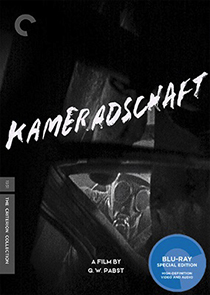 Kameradschaft
Kameradschaft
Year: 1931
Director: G. W. Pabst
Kameradschaft starts suddenly, as these things do: Deep beneath the earth, in a mine located on the border separating Germany from France, itself divided into two distinct sections based on nationality, a fire smolders. The French build walls around it to contain it, but you can’t contain fire with brick forever. Eventually, the mine explodes and collapses, trapping French miners in droves, their families on the surface watching smoke billow from the mine in helpless awe. Kameradschaft is one of the form’s early disaster movies, and like contemporary disaster movies it hones in on humanity uniting in the face of common catastrophe. (It’s also based, if loosely, on an actual disaster, the Courrières mine disaster of 1906.) The Germans put together a team to save the day, convincing their bosses and their countrymen that intervening is simply the right thing to do. Borders don’t matter. Tensions between nations don’t matter. Risk to life and limb doesn’t matter. (Wittkopp [Ernst Busch], the German miner leading the effort to rescue the French, proclaims that they’d come to his aid if the shoe was on the other foot.) But those tensions have to be established before any thrilling heroics take place, whether in a game of marbles between bickering sons of French and German border guards or in a beer hall misunderstanding. The tensions chafing both countries are palpable.The note of humanity on which the film ends, which is more like a full-blown symphony, reveals them as wastefully petty. It’s a cathartic moment that still applies more than eight decades after its release. —Andy Crump
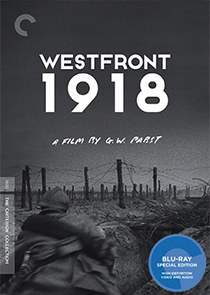 Westfront 1918
Westfront 1918
Year: 1930
Director: G.W. Pabst
Is Westfront 1918 the better made Pabst film in Criterion’s January release slate or is it just better preserved? Compared to Kameradschaft, the 2K restoration of Pabst’s trench warfare reenactment looks downright pristine, and even then it’s still cobbled together using a duplicate negative. Maybe praising Westfront 1918’s crisper image quality isn’t fair when we’re talking about movies necessarily stitched up using the spare parts our international film archives have in their possession. But Kameradschaft and Westfront 1918 are different movies not only in terms of the quality of their restorations, but in terms of their purposes. Kameradschaft nearly counts as a feel-good movie, though it takes place primarily beneath the earth, in the dark, where all is engulfed by flames. (The Hell motif isn’t easily missed.) Westfront 1918 takes place within a different kind of Hell, wherein you’re stuck in a ditch with comrades, lobbing explosives at enemies who occasionally turn out to be your allies. If you’re lucky enough to go home, you’re actually not lucky at all, because “home” has morphed into a barren pit of starvation and hopelessness. There’s no reprieve from the soul-sucking awfulness of war, not even in the arms of your wife, mostly because her arms are full of the butcher and his meat. (Not actually a play on words, but close enough.) Kameradschaft ends with a warm, life-affirming celebration. Westfront 1918 ends with literal madness and heartbreaking regret. Both films are rooted in actual events, but Westfront 1918’s vision of war’s boundless ruin ultimately feels all too real. —Andy Crump